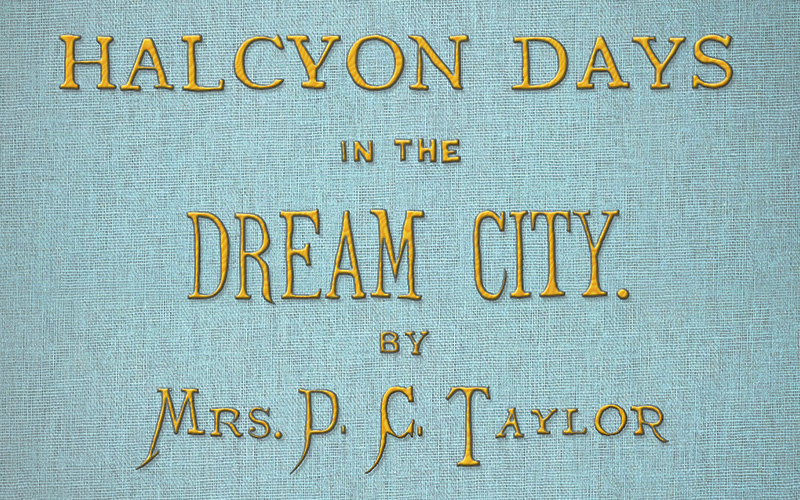Halcyon Days in the Dream City
by Mrs. D. C. Taylor
Continued from Part 13

We dreamed that we sat upon the sands of the lake shore, and that all about us, unnumbered as these sands, sat and stood a great multitude; thousands upon thousands of people, men, women, and children, from the babe in arms to the maiden and stripling, high and low, rich and poor, all crowding together, all were equal, and over all a great hush and calm.
The sun was setting. Our faces were turned to the east and we saw only the reflection of his dying glories. The solemn heaving water slowly darkened, as we gazed; a faint streak of rose faded in the sky; a gentle breeze fanned our cheeks, and so quiet was the multitude of beings that the gentle roll and murmur of the light incoming waves and their soft whisper as they broke upon the sand was plainly audible. The daylight faded “and darkness fell upon the face of the waters.”
We dreamed we were alone in that vast throng, yet safe and calm as in a mother’s bosom; every man was our brother, every woman our sister, every eye was kind, every voice was courteous and gentle; the spirit of peace brooded over us. Suddenly a great light streamed out and moving slowly, showed us pictures on sea and land; a white sailed ship “far, far at sea;” a great steamer crowded with human freight; a wide lone expanse of tossing white capped waves, on land, a shadowy dome with silver cross or crescent; a glimpse of the stretching multitude miles away; a spit of silvery sand with a dark boat moored to its side; tall spires, roofs, and black motionless trees; then darkness.[1]
Fireworks on the Lake Front. [Image from Harper’s Weekly, Oct. 9, 1893.]
Suddenly glowed out a long line of resplendent stars, blue, red, green, white, apparently shining upon the surface of the water. They burned and glowed larger and larger, casting long colored streams of light till finally they broke into fountains of living fire, that rose in streaming showers, brighter, brighter, they too faded, fell.
Then came: a rattling like a fusillade of small arms, and the heavens were painted full of balls, and stars, and whirling wheels, and shrieking, streaming comets, and huge, slow, dropping tears of fire in every color of the rainbow; these too, fell, and the lake swallowed them up. Then followed a carnival a rage of fire and color and splendor; blossoms and banners and fairy palaces of light, that rushed across the heavens blindingly, and plunged seething into the water, and the immutable lake swallowed them up, buried them deep in its bosom, and slipped and whispered as calmly as if that passion of magnificence had never been.[2]
The Lagoon and Wooded Island at night. [Image from Hitchcock, Ripley The Art of the World Illustrated in the Paintings, Statuary, and Architecture of the World’s Columbian Exposition. D. Appleton, 1895.]
“View from the Island at Night” drawn by A. Castaigne. [Image from the Century Magazine, Sept. 1893.]
Our dream was over; but its memory abides with us, and will, while we inhabit this house of mortality.
Continued in Part 15
NOTES
[1] Mrs. Taylor is, of course, describing the evening fireworks show, which included a variety of incendiary effects. Programs describing each often were published in advance, with some depictions in regular rotation and others made especially for one show (such as the bust of the Infanta of Spain on the fireworks program for Princess Eulalia Day and American history vignettes on the Fourth of July.)
[2] One report described the scene this way: “Stretching along the half-mile expanse of the lake shore between the war vessel State of Illinois and Music Hall was a great open area which was densely packed with people almost every evening. … Probably no city in this country ever had such elaborate pyrotechnic displays as Chicago had in connection with the Exposition. [“Display of Fireworks at the Columbian Exposition” Scientific American December 2, 1893, p. 359.]

